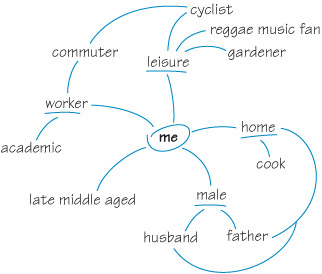2.3 Spider diagrams
Spider diagrams are simple ways of displaying information and can be quickly created and easily adapted. The purpose of the spider diagram below is to display information about an individual’s group membership: the title is ‘Belonging to many groups’. What information can be understood from it? Three of the groups are ‘male’, ‘leisure’ and ‘worker’. Leisure is subdivided into groups which include gardening and cycling. There is a link between cycling as a leisure activity and cycling as a means of commuting to a place of work. From all the information given, it is possible to say that this spider diagram has been drawn by a ‘late middle aged’ family man, who cooks some meals at home when not gardening, cycling or playing reggae music. He works as an academic and he commutes to his place of work by bike.
Figure 3 is an example of a spider diagram.
Activity 3 Who am I?
This activity is designed so that you can apply the idea that individual identity is built up from membership of different groups. Think about the different groups you consider yourself to be part of. A useful starting point is family relationships, friendships, work, hobbies, interests.
Don’t forget being a learner on this Open University badged open course!
Then create a spider diagram in your notebook to illustrate how these connections work. Start, as in Figure 4, by putting yourself in the centre of the page using the word ‘me’. Then, for each group you belong to, begin a new branch from the centre and label it. If you want you can also have a further level of groups, linked to the main groups by more branches.
You may want to show a connection, a branch line, between groups as illustrated in Figure 4 between cycling for leisure and cycling as a means of commuting.
Comment
Were you surprised at the number of groups you were able to put into your diagram?
Do you belong to overlapping groups? For example if you identified yourself as a woman you may have put ‘sister’ as a group, but sister belongs too in a ‘family’ or ‘home’ group if you have one.
Whatever you included in your spider diagram, the experience of belonging to many groups, and the diverse cultures associated with them, will contribute in different ways to your sense of who you are, or, to put it another way, your identity.
You have been looking at how your identity is in part derived from the social groups you belong to. You have also briefly considered how behaviour or lifestyle can demonstrate membership of a group.
This raises an interesting question: if you can ‘see’ your own identity through the way you belong to different groups, then perhaps other people can see that identity too. You will consider this in more detail next.

